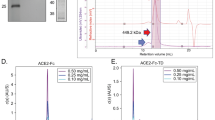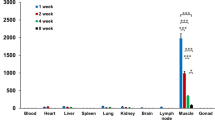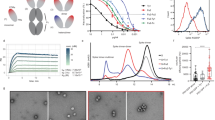Abstract
Immunosuppressed (IS) patients, such as recipients of hematopoietic stem cell transplantation, occasionally develop severe and fatal adenovirus (Ad) infections. Here, we analyzed the potential of a virus receptor trap based on a soluble coxsackievirus and Ad receptor (sCAR) for inhibition of Ad infection. In vitro, a dimeric fusion protein, sCAR-Fc, consisting of the extracellular domain of CAR and the Fc portion of human IgG1 and a monomeric sCAR lacking the Fc domain, were expressed in cell culture. More sCAR was secreted into the cell culture supernatant than sCAR-Fc, but it had lower Ad neutralization activity than sCAR-Fc. Further investigations showed that sCAR-Fc reduced the Ad infection by a 100-fold and Ad-induced cytotoxicity by ~20-fold. Not only was Ad infection inhibited by sCAR-Fc applied prior to infection, it also inhibited infection when used to treat ongoing Ad infection. In vivo, sCAR-Fc was delivered to IS mice by an AAV9 vector, resulting in persistent and high (>40 μg ml−1) sCAR-Fc serum levels. The sCAR-Fc serum concentration was sufficient to significantly inhibit hepatic and cardiac wild-type Ad5 infection. Treatment with sCAR-Fc did not induce side effects. Thus, sCAR-Fc virus receptor trap may be a promising novel therapeutic for treatment of Ad infections.
This is a preview of subscription content, access via your institution
Access options
Subscribe to this journal
Receive 12 print issues and online access
$259.00 per year
only $21.58 per issue
Buy this article
- Purchase on Springer Link
- Instant access to full article PDF
Prices may be subject to local taxes which are calculated during checkout








Similar content being viewed by others
Accession codes
References
Garnett CT, Erdman D, Xu W, Gooding LR . Prevalence and quantitation of species C adenovirus DNA in human mucosal lymphocytes. J Virol 2002; 76: 10608–10616.
Ganzenmueller T, Buchholz S, Harste G, Dammann E, Trenschel R, Heim A . High lethality of human adenovirus disease in adult allogeneic stem cell transplant recipients with high adenoviral blood load. J Clin Virol 2011; 52: 55–59.
Florescu DF, Pergam SA, Neely MN, Qiu F, Johnston C, Way S et al. Safety and efficacy of CMX001 as salvage therapy for severe adenovirus infections in immunocompromised patients. Biol Blood Marrow Transplant 2012; 18: 731–738.
Lion T, Baumgartinger R, Watzinger F, Matthes-Martin S, Suda M, Preuner S et al. Molecular monitoring of adenovirus in peripheral blood after allogeneic bone marrow transplantation permits early diagnosis of disseminated disease. Blood 2003; 102: 1114–1120.
Rosario RF, Kimbrough RC, Van Buren DH, Laski ME . Fatal adenovirus serotype-5 in a deceased-donor renal transplant recipient. Transpl Infect Dis 2006; 8: 54–57.
Steiner I, Aebi C, Luthy AR, Wagner B, Leibundgut K . Fatal adenovirus hepatitis during maintenance therapy for childhood acute lymphoblastic leukemia. Pediatr Blood Cancer 2008; 50: 647–649.
Ivan D, Frazier OH, Abrams J . Fatal disseminated adenoviral infection in an adult heart transplant patient. J Heart Lung Transplant 2004; 23: 1209–1212.
Kajon AE, Dickson LM, Fisher BT, Hodinka RL . Fatal disseminated adenovirus infection in a young adult with systemic lupus erythematosus. J Clin Virol 2011; 50: 80–83.
Schilham MW, Claas EC, van Zaane W, Heemskerk B, Vossen JM, Lankester AC et al. High levels of adenovirus DNA in serum correlate with fatal outcome of adenovirus infection in children after allogeneic stem-cell transplantation. Clin Infect Dis 2002; 35: 526–532.
Kojaoghlanian T, Flomenberg P, Horwitz MS . The impact of adenovirus infection on the immunocompromised host. Rev Med Virol 2003; 13: 155–171.
Vyas JM, Marasco WA . Fatal fulminant hepatic failure from adenovirus in allogeneic bone marrow transplant patients. Case Rep Infect Dis 2012; 2012: 463569.
Wy Ip W, Qasim W . Management of adenovirus in children after allogeneic hematopoietic stem cell transplantation. Adv Hematol 2013; 2013: 176418.
Philipson L, Pettersson RF . The coxsackie-adenovirus receptor—a new receptor in the immunoglobulin family involved in cell adhesion. Curr Top Microbiol Immunol 2004; 273: 87–111.
Tomko RP, Xu R, Philipson L . HCAR and MCAR: the human and mouse cellular receptors for subgroup C adenoviruses and group B coxsackieviruses. Proc Natl Acad Sci USA 1997; 94: 3352–3356.
Wang X, Bergelson JM . Coxsackievirus and adenovirus receptor cytoplasmic and transmembrane domains are not essential for coxsackievirus and adenovirus infection. J Virol 1999; 73: 2559–2562.
Waddington SN, McVey JH, Bhella D, Parker AL, Barker K, Atoda H et al. Adenovirus serotype 5 hexon mediates liver gene transfer. Cell 2008; 132: 397–409.
Pinkert S, Westermann D, Wang X, Klingel K, Dorner A, Savvatis K et al. Prevention of cardiac dysfunction in acute coxsackievirus B3 cardiomyopathy by inducible expression of a soluble coxsackievirus-adenovirus receptor. Circulation 2009; 120: 2358–2366.
Pinkert S, Klingel K, Lindig V, Dorner A, Zeichhardt H, Spiller OB et al. Virus-host coevolution in a persistently coxsackievirus B3-infected cardiomyocyte cell line. J Virol 2011; 85: 13409–13419.
Yanagawa B, Spiller OB, Proctor DG, Choy J, Luo H, Zhang HM et al. Soluble recombinant coxsackievirus and adenovirus receptor abrogates coxsackievirus b3-mediated pancreatitis and myocarditis in mice. J Infect Dis 2004; 189: 1431–1439.
McCarty DM, Fu H, Monahan PE, Toulson CE, Naik P, Samulski RJ . Adeno-associated virus terminal repeat (TR) mutant generates self-complementary vectors to overcome the rate-limiting step to transduction in vivo. Gene Ther 2003; 10: 2112–2118.
Nishii H, Nomura M, Fujimoto N, Matsumoto T . Up-regulation of interleukin-6 gene expression in cyclophosphamide-induced cystitis in mice: an in situ hybridization histochemical study. Int J Urol 2006; 13: 1339–1343.
Girard BM, Cheppudira BP, Malley SE, Schutz KC, May V, Vizzard MA . Increased expression of interleukin-6 family members and receptors in urinary bladder with cyclophosphamide-induced bladder inflammation in female rats. Front Neurosci 2011; 5: 20.
Jimenez-Clavero MA, Escribano-Romero E, Ley V, Spiller OB . More recent swine vesicular disease virus isolates retain binding to coxsackie-adenovirus receptor, but have lost the ability to bind human decay-accelerating factor (CD55). J Gen Virol 2005; 86: 1369–1377.
Christiansen D, Devaux P, Reveil B, Evlashev A, Horvat B, Lamy J et al. Octamerization enables soluble CD46 receptor to neutralize measles virus in vitro and in vivo. J Virol 2000; 74: 4672–4678.
Yanagawa B, Spiller OB, Choy J, Luo H, Cheung P, Zhang HM et al. Coxsackievirus B3-associated myocardial pathology and viral load reduced by recombinant soluble human decay-accelerating factor in mice. Lab Invest 2003; 83: 75–85.
Kaplan G, Freistadt MS, Racaniello VR . Neutralization of poliovirus by cell receptors expressed in insect cells. J Virol 1990; 64: 4697–4702.
Greve JM, Forte CP, Marlor CW, Meyer AM, Hoover-Litty H, Wunderlich D et al. Mechanisms of receptor-mediated rhinovirus neutralization defined by two soluble forms of ICAM-1. J Virol 1991; 65: 6015–6023.
Goodfellow IG, Evans DJ, Blom AM, Kerrigan D, Miners JS, Morgan BP et al. Inhibition of coxsackie B virus infection by soluble forms of its receptors: binding affinities, altered particle formation, and competition with cellular receptors. J Virol 2005; 79: 12016–12024.
Shafren DR, Dorahy DJ, Greive SJ, Burns GF, Barry RD . Mouse cells expressing human intercellular adhesion molecule-1 are susceptible to infection by coxsackievirus A21. J Virol 1997; 71: 785–789.
Harris CL, Williams AS, Linton SM, Morgan BP . Coupling complement regulators to immunoglobulin domains generates effective anti-complement reagents with extended half-life in vivo. Clin Exp Immunol 2002; 129: 198–207.
Marchant D, Si X, Luo H, McManus B, Yang D . The impact of CVB3 infection on host cell biology. Curr Top Microbiol Immunol 2008; 323: 177–198.
Lim BK, Choi JH, Nam JH, Gil CO, Shin JO, Yun SH et al. Virus receptor trap neutralizes coxsackievirus in experimental murine viral myocarditis. Cardiovasc Res 2006; 71: 517–526.
Kalyuzhniy O, Di Paolo NC, Silvestry M, Hofherr SE, Barry MA, Stewart PL et al. Adenovirus serotype 5 hexon is critical for virus infection of hepatocytes in vivo. Proc Natl Acad Sci USA 2008; 105: 5483–5488.
Waddington SN, Parker AL, Havenga M, Nicklin SA, Buckley SM, McVey JH et al. Targeting of adenovirus serotype 5 (Ad5) and 5/47 pseudotyped vectors in vivo: fundamental involvement of coagulation factors and redundancy of CAR binding by Ad5. J Virol 2007; 81: 9568–9571.
Shayakhmetov DM, Gaggar A, Ni S, Li ZY, Lieber A . Adenovirus binding to blood factors results in liver cell infection and hepatotoxicity. J Virol 2005; 79: 7478–7491.
Tomko RP, Johansson CB, Totrov M, Abagyan R, Frisen J, Philipson L . Expression of the adenovirus receptor and its interaction with the fiber knob. Exp Cell Res 2000; 255: 47–55.
Yun CO, Yoon AR, Yoo JY, Kim H, Kim M, Ha T et al. Coxsackie and adenovirus receptor binding ablation reduces adenovirus liver tropism and toxicity. Hum Gene Ther 2005; 16: 248–261.
Heim A, Ebnet C, Harste G, Pring-Akerblom P . Rapid and quantitative detection of human adenovirus DNA by real-time PCR. J Med Virol 2003; 70: 228–239.
Neofytos D, Ojha A, Mookerjee B, Wagner J, Filicko J, Ferber A et al. Treatment of adenovirus disease in stem cell transplant recipients with cidofovir. Biol Blood Marrow Transplant 2007; 13: 74–81.
Gustafson I, Lindblom A, Yun Z, Omar H, Engstrom L, Lewensohn-Fuchs I et al. Quantification of adenovirus DNA in unrelated donor hematopoietic stem cell transplant recipients. J Clin Virol 2008; 43: 79–85.
Engelmann G, Heim A, Greil J, Schmitt CP, Flechtenmacher C, Daum E et al. Adenovirus infection and treatment with cidofovir in children after liver transplantation. Pediatr Transplant 2009; 13: 421–428.
Inagaki K, Fuess S, Storm TA, Gibson GA, McTiernan CF, Kay MA et al. Robust systemic transduction with AAV9 vectors in mice: efficient global cardiac gene transfer superior to that of AAV8. Mol Ther 2006; 14: 45–53.
Fechner H, Sipo I, Westermann D, Pinkert S, Wang X, Suckau L et al. Cardiac-targeted RNA interference mediated by an AAV9 vector improves cardiac function in coxsackievirus B3 cardiomyopathy. J Mol Med (Berl) 2008; 86: 987–997.
Fechner H, Wang X, Srour M, Siemetzki U, Seltmann H, Sutter AP et al. A novel tetracycline-controlled transactivator-transrepressor system enables external control of oncolytic adenovirus replication. Gene Ther 2003; 10: 1680–1690.
Sipo I, Knauf M, Fechner H, Poller W, Planz O, Kurth R et al. Vaccine protection against lethal homologous and heterologous challenge using recombinant AAV vectors expressing codon-optimized genes from pandemic swine origin influenza virus (SOIV). Vaccine 2011; 29: 1690–1699.
Geisler A, Jungmann A, Kurreck J, Poller W, Katus HA, Vetter R et al. microRNA122-regulated transgene expression increases specificity of cardiac gene transfer upon intravenous delivery of AAV9 vectors. Gene Ther 2011; 18: 199–209.
Eckstein A, Grossl T, Geisler A, Wang X, Pinkert S, Pozzuto T et al. Inhibition of adenovirus infections by siRNA-mediated silencing of early and late adenoviral gene functions. Antiviral Res 2010; 88: 86–94.
Toth K, Spencer JF, Dhar D, Sagartz JE, Buller RML, Painter GR et al. Hexadecyloxypropyl-cidofovir, CMX001, prevents adenovirus-induced mortality in a permissive, immunosuppressed animal model. Proc Natl Acad Sci USA 2008; 105: 7293–7297.
Acknowledgements
This work was supported by the Deutsche Forschungsgemeinschaft (DFG) (Grants FE785/2-2, FE785, 3-1, FE785/4-1 to HF, Ku 1436/6-1 to JK) and by a doctoral studies grant to CR from the Sonnenfeld Stiftung. We thank Erik Wade for critical reading of the manuscript and helpful comments and Xiaomin Wang for helpful assistance with Wt-Ad5 preparation.
Author information
Authors and Affiliations
Corresponding author
Ethics declarations
Competing interests
The authors declare no conflict of interest.
Additional information
Supplementary Information accompanies this paper on Gene Therapy website
Rights and permissions
About this article
Cite this article
Röger, C., Pozzuto, T., Klopfleisch, R. et al. Expression of an engineered soluble coxsackievirus and adenovirus receptor by a dimeric AAV9 vector inhibits adenovirus infection in mice. Gene Ther 22, 458–466 (2015). https://doi.org/10.1038/gt.2015.19
Received:
Revised:
Accepted:
Published:
Issue Date:
DOI: https://doi.org/10.1038/gt.2015.19
This article is cited by
-
Human Coxsackie- and adenovirus receptor is a putative target of neutrophil elastase-mediated shedding
Molecular Biology Reports (2022)



